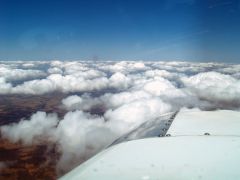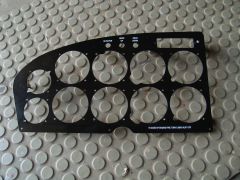
mike20papa
Basic Member-
Posts
359 -
Joined
-
Last visited
Content Type
Profiles
Forums
Blogs
Gallery
Downloads
Media Demo
Events
Everything posted by mike20papa
-
Another,, "Should I buy this Mooney" thread
mike20papa replied to mpg's topic in Vintage Mooneys (pre-J models)
Find out what prop hub the "0" time prop has - when was it overhauled - five years ago, or this year. And when was this annual done 5 years ago, or this year. Any airplane that has been sitting for 5 years would need more than just the typ. annual done to it. Airframe corrosion is always a possibility, leaking tanks, old & tired shock disks. The airplane appears to be minimally maintained, so possibly lots of opportunities for the new owner. Remember the saying, decide what airplane you want and look for what may appear to be the most expensive one out there. Being a buyers market, the reasoning is that all owners are selling dollars invested for dimes, the more dimes you can spend the more dollars worth of aircraft you are going to end up with. Unless you're a young guy with lots of $$ looking for a project - just my 2 cents worth (and experience). -
What are the mag checks like? Same as before? Start up & idle? Try the mag checks at an overly lean mixture, so that rpm is limited by mixture, then mag check again. You will get more like a 100 to 150rpm drop each mag. This lean run-up method is reported to be more telling of mag, plug, plug wire problems. Good luck!
-
Thinking about flying to San Antonio tomorrow.
mike20papa replied to FloridaMan's topic in General Mooney Talk
I'd say Stinson field is the GA airport of choice in San Antonio, but located in the older part of town. New Braunfels KBAZ is close by and a vacation town. Has a couple of crew cars, plenty of hotels (if it's not spring break - is it!?) Towered field but not much traffic. Lots of MOA's around San Antonio. San MArcos is a little further away, great airport, also towered but minimal traffic - Mooney shop on the field. -
Reliability, for one. Plus the original toggle has a limited amperage rating compared to a battery master solenoid. But! I certainly wouldn't fret over it! Again, though a battery master solenoid can turn itself off..if the solenoid looses it's ground. And that's not unheard of. Look for one (if you replace it) that has a separate (redundant to the housing) ground wire/terminal. I know Lamar sells one. I have a copy of the 337 I used to replace mine. A lot of older aircraft had this large toggle switch for a battery master. Ercoupes come to mind and there is a STC to replace them. Also, the cable actuates another toggle switch - can't remember for sure - I'd have to look at the wiring diagram. Perhaps the alt. field? Do you still have the original charging system with regulator? You need to know exactly how the airplane is currently wired before doing anything. Make sure you know the existing systems and any modifications before hand and talk to your A&P/IA. Right now, I'd just fly the airplane. I need paint, but everytime I walk in the hangar N8335E always says "FLY ME" have yet to hear "PAINT ME"
-
Vintage Mooney Cowling Mod
mike20papa replied to Sabremech's topic in Vintage Mooneys (pre-J models)
David, your work looks great! Good move having the ARI cowling as a departure point and incorporating the James components. Joe -
Yes, the wiring over the years gets modified and remodified and some A&P's think that AC wiring in the GA fleet is "generally appauling". I lost a com radio one day before I decided to do my panel upgrade - which one thing leading to another..a complete rewiring of the AC. Anyway my Com 1 was powered off the inst. panel lights, just twisted together - in the cabin roof area! The wiring behind the panel looked like a rats nest and I had just spent a considerable amount of $$ getting a Garmin audio panel put in. Not that the job was poorly done, it's just working on wiring behind the panel - with out removing the windshield - is like building a ship in a bottle. Wesley, do you have the old mechanical master switch - cable actuated toggle - or did Doug install a master solenoid? I see that Skytech is now selling PMA'd master & starter relays (solenoids). Lamar was the only previous alternate source. I think another source of concern/design is the lack of redundant ground connections. The lighting effecting the engine temp readings could be not so much a lack of potential, but a lack of ground raising circuit resistance. The ground wire sizing and integrety of connections (especially) Joe
-
Wesley, Could also be the shielding on the strobe power wiring, maybe? Make sure the ground strap from the engine to the firewall is good, clean & tight connection. If it comes back, try powering up your avionics without the engine running, or did you do that?
-
We all know the various engine temp.s we all see from A models thru C's. Recently I've began to notice the various routing used to feed the oil cooler from the accessory case and think there may be some correlation to engine temps. Seems as though some 180 hp Mooneys have no temp problems (unless we forget to open the cowling flaps!) were some experience high engine temps regardless of efforts made to sealing baffles, etc. So, I'm a lucky dude as I have no issue with engine temps - sometimes even see less than 300F CHT's at low power setting cruise and 330 at 70% power. I never see oil temps over 190F (and I live in TX) generally around 185F (good/new Electronics Int. instrumentation) My oil lines run down from the accessory case, then forward to the cooler at the bottom of the cowling. I see lots of 180hp mooneys that run the lines thru the dog house on top of the cyl.s, then down to the cooler. My dog house tin has patches to close off the old routing. Don't know the history behind that, either. So, anyone want to chime in? Joe/N8335E
-
O-360 fuel systems.... 1. DESIGN fuel pressure is the sole function of the integral pressure regulators built into the fuel pumps. This pressure is specified by Lycoming as 2 - 5psi at the carb inlet. Mooney green arks on the gauges are based on this spec. The original & replacement fuel pumps are also mfg. to this spec. The carb has a special port for attachment of the pressure gauge line at the inlet to monitor this spec. PSI. 2. The float type carberator has no way of influencing the fuel pressure outside of the spec. PSI. Period. The fuel pumps are designed to supply the required amount of fuel within the spec. PSI regardless of the float needle valve opening. The carb has a dumb float level actuated "on/off" valve at the fuel line inlet. To think otherwise is like believing the float valve in your bathroom toilet tank can significantly effect the water pressure in the water main down town...IF it is effecting the PSI, you have a dangerous - "hazardous to your health" - restriction in either the supply or vent piping. 3. Fuel flows from the tanks, to the selector valve, to the aux. fuel pump, thru the gascolator and then to the engine driven pump then to the carb via the float valve into the float then metered into the engine intake. 4. There are 3 filters that the fuel passes thru (actually 4 on my A model - if you count the coase finger screens in the tanks. The other three filter screens are very fine - the first is in the elec. pump, under the cap at the end of the pump (Bendix/Faucet type). ALL fuel first hits this screen and Mooney put out a SB decades ago recommending checking these every 50 hr.s If I had old slosh sealer in my fuel tanks (which the A models do NOT) - I'd do this religiously! The second filter screen is in the gascolator - but seriously doubt anything would get past the first screen in the electric pump, but it's there. Then of course the sediment bowl in the gascolator, FINALLY there is a very fine finger screen inside the carb inlet - suppose to be checked at annual. Requires a special locking ring to secure the fitting - AC Spruse sells them. 5. Inhibited fuel flow will not show a pressure drop unless there is a high demand for fuel flow from the engine. Fuel flow and therefore pressure..can be inhibited by clogged screens or lines on the pressure side - AND just as important - clogged VENT lines can inhibit fuel flow and pressure. It's rather doubtful that all vent lines should clog at the same time, so fuel selector valve switching during runup should analize this problem. 6. IF you don't have 2 - 5 psi at run up with the aux. fuel pump OFF or ON - do NOT go flying. Things won't improve after you leave the ground. Get a knowledgeable dude to look things over and turn the wrenches on those delicate alumn. fittings. Fuel is your life blood - you should know the system. And it will help keep our Mooney insurance rates low/affordable, too!
-
Baggage door will soon fly on its own in my 1962 M20C
mike20papa replied to kommers's topic in Vintage Mooneys (pre-J models)
Years back, when I was first flying my A model, I once took off without latching the baggage door (?!) I realized my error pretty quickly & drug the airplane around the pattern at about 500ft AGL & 80mph - the whole time all I could imagine was that door departing the fuselage & hitting the tail! Then just to add to the excitement...on short final, the door closed with a WHAM! I got out, inspected the hinge and swore I'd repay N8335E for my episode by replacing the original rolled piece of crap hinge with an extruded 2024T3 replacement. Took me at least 4 hr.s ! - you have to partially drop the headliner, match drill the hinge leafs (challenging! you must reuse the exist holes - or else just risk make things worse) Then cutting the hardened steel hinge pin - takes a dremmel tool with an abrasive wheel. If memory serves me...the hinge is machine screwed to the fuselage, rivets to the door. My other blessing was that my flight was witnessed by only about 2 million pine trees - not a single human - as I was at a small airport in East Texas! Always discuss with your A&P/IA before you even think about it! -
Mixture rich, WOT & 2700 rpm climbing - I see around 1250 EGT's & 360 CHT (if it's below 50F - I'll close cowling flaps a bit) and even in TX summer around 380 max. I have the cowling closure and I usually climb around 110 - 120 mph. I then lean to target around 1300 to 1350 EGT's above 3000ft. I don't see big difference in cooling temps with climb speed. If CHT's are a concern, check the wool baffle seals around the lower part of the front air dam below the spinner. The original wool baffle seals are often missing, or no longer fitting - especially if new light weight starter & alternator installed. The fun part - sealing off the prop. gov. oil line and around the alt/gen braket. Here's a photo of mine after rework. The wool material available from AC Spruce.
-
Is it just me? Takeoff vs Landing in crosswind
mike20papa replied to Bob - S50's topic in General Mooney Talk
Definately. On final in a X-wind you cross control to maintain runway alignment and as speed decreases control input increases to counter drift & yaw. It all happens at a predictable rate from an established set of control inputs. You just fly the airplane down to the runway in a controlled slip starting from a known reference you don't really have to even know the numerical values of the wind speed & vector - the AC will tell you all you need to know and if you have enough control authority to handle the Xwind component at touch down - as you judge runway alignment.. With a take off, it's just the opposite, You need to know the xwind componets before advancing the throttle, you need a definate starting point to set aileron x control and then you need to know left or right x wind as to what to expect rudder wise when you rotate. I have flown off in strong xwinds - especially if from the left - demanding even more right rudder to counter act the weather vaning effect - that I have FULL right rudder to counter "P" factor and still fying hard yawed left and thinking something must be "broken" But, here in Texas, we fly some stiff x-winds or you don't fly at all. But I will say a good x-wind take off is very rewarding! And it's done smoothly, not by holding the AC to the pavement, then jerking it OFF!? -
From the album: aerial views
-
From the album: aerial views
-
From the album: aerial views
-
From the album: aerial views
-
Anybody have a Slick Start on your plane?
mike20papa replied to DaV8or's topic in General Mooney Talk
Yes, I have one on my o-360 (carb) 180hp A model. My airplane always impresses other pilots - how easy it starts. -
Congratulations on the new M20A! I own/fly N8335E, '59 wood wing. You got a great example as the previous owner in California took great care of the airplane. I think I have an extra baggage door hold-open-thingy. I made a new one out of 4130 as the originals are bit flexible. It wouldn't take much to make the door hold open rod, either.. Joe in Bryan, TX hangar at KCFD.
-
Fuel gauge troubleshooting ideas
mike20papa replied to Johnnybgoode's topic in Vintage Mooneys (pre-J models)
The old senders are mechanical rheostats. They can be smooth running for only so many decades and then they can start to hang up, until the fuel sloshes around in flight or landing and then then start "reading" correctly. If it's a ground problem they probably work or they dont. You can also rock the airplane on the ground by moving the tail cone up & down - see if the gauges respond. Good Luck. -
Vintage Mooney Cowling Mod
mike20papa replied to Sabremech's topic in Vintage Mooneys (pre-J models)
Another problem common on the 180hp models is the poorly designed carb induction box & boot. It transmits way to much engine vibration into the lower cowling section. Rarely do you see a 180hp Mooney without patch work around the numerous openings - (light, carb opng, oil cooler) the vibration also eats up carb heat boxes, and cowling flaps, not to mention the rubber boot. Some airplanes, the boot is attached to the carb heat box with a doubled up hose clamp and the lower clamp has actually worn a hole/groove into the lower cowling. Best of luck. The James do fantastic work. So, have you gone thru the STC process, before? I don't think the overall shape of the cowling is going to be easily improved without some kind of prop extension and that will drive the FAA guys into a state of hyper anxiety. -
Can I use car battery charger for the Mooney?
mike20papa replied to par's topic in Vintage Mooneys (pre-J models)
http://www.batterymart.com/p-cm6a-schauer-automatic-charger-desulfator.html?utm_source=google&utm_medium=cpc&utm_term=CM6A&utm_campaign=PLA&gclid=CIrWqPCU7MMCFQwKaQodhwYAhg Schauer Battery Master Charger. $45.00 Has settings for AGM (absorbative glass mat) batteries, is microprocessor controlled and has a "rejuvenating" selection for desulfinating batteries. I've been using one to keep my Concorde up to snuff when I'm down for annual. The rejuvenating cycle actually brought a friends Concorde back to life - after it had been sitting for over a year. Also..you CAN use it on your car! -
Got copies of the original panel dwg. from Mooney. Modified flight panel to standard "6 pack" and fabed up bent mounting tabs to retain the original tilt for gyro's to work. Cut the panel myself (I'm also a homebulder) and did all the work under my IA. My IA also required me to go thru a lengthly pre-approval process, before any work started. I submitted dwg.s, etc,etc. to FSDO. Had avionics wiring harness "pre-wired" by a local shop, signed off. LOTS OF WORK! But well worth it! Just talk to your IA first, I think some are not so strict. I also think recently the FAA has given them even more field approval authority.







